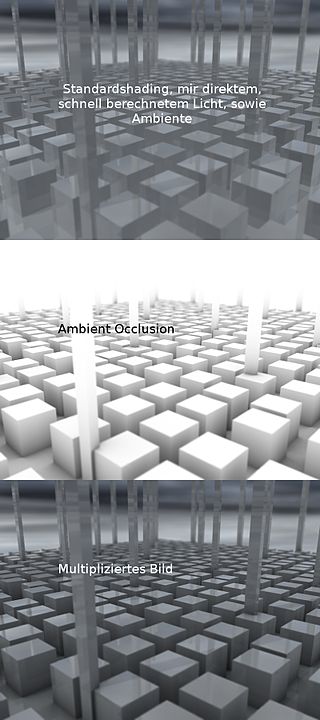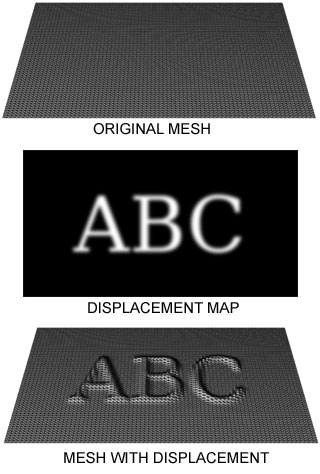
Rendering or image synthesis is the process of generating a photorealistic or non-photorealistic image from a 2D or 3D model by means of a computer program. The resulting image is referred to as the render. Multiple models can be defined in a scene file containing objects in a strictly defined language or data structure. The scene file contains geometry, viewpoint, texture, lighting, and shading information describing the virtual scene. The data contained in the scene file is then passed to a rendering program to be processed and output to a digital image or raster graphics image file. The term "rendering" is analogous to the concept of an artist's impression of a scene. The term "rendering" is also used to describe the process of calculating effects in a video editing program to produce the final video output.

Bump mapping is a texture mapping technique in computer graphics for simulating bumps and wrinkles on the surface of an object. This is achieved by perturbing the surface normals of the object and using the perturbed normal during lighting calculations. The result is an apparently bumpy surface rather than a smooth surface although the surface of the underlying object is not changed. Bump mapping was introduced by James Blinn in 1978.

Shadow volume is a technique used in 3D computer graphics to add shadows to a rendered scene. They were first proposed by Frank Crow in 1977 as the geometry describing the 3D shape of the region occluded from a light source. A shadow volume divides the virtual world in two: areas that are in shadow and areas that are not.
A first-person shooter engine is a video game engine specialized for simulating 3D environments for use in a first-person shooter video game. First-person refers to the view where the players see the world from the eyes of their characters. Shooter refers to games which revolve primarily around wielding firearms and killing other entities in the game world, either non-player characters or other players.

A lightmap is a data structure used in lightmapping, a form of surface caching in which the brightness of surfaces in a virtual scene is pre-calculated and stored in texture maps for later use. Lightmaps are most commonly applied to static objects in applications that use real-time 3D computer graphics, such as video games, in order to provide lighting effects such as global illumination at a relatively low computational cost.

CryEngine is a game engine designed by the German game developer Crytek. It has been used in all of their titles with the initial version being used in Far Cry, and continues to be updated to support new consoles and hardware for their games. It has also been used for many third-party games under Crytek's licensing scheme, including Sniper: Ghost Warrior 2 and SNOW. Warhorse Studios uses a modified version of the engine for their medieval RPG Kingdom Come: Deliverance. Ubisoft maintains an in-house, heavily modified version of CryEngine from the original Far Cry called the Dunia Engine, which is used in their later iterations of the Far Cry series.

Parallax mapping is an enhancement of the bump mapping or normal mapping techniques applied to textures in 3D rendering applications such as video games. To the end user, this means that textures such as stone walls will have more apparent depth and thus greater realism with less of an influence on the performance of the simulation. Parallax mapping was introduced by Tomomichi Kaneko et al., in 2001.

In 3D computer graphics, modeling, and animation, ambient occlusion is a shading and rendering technique used to calculate how exposed each point in a scene is to ambient lighting. For example, the interior of a tube is typically more occluded than the exposed outer surfaces, and becomes darker the deeper inside the tube one goes.

High-dynamic-range rendering, also known as high-dynamic-range lighting, is the rendering of computer graphics scenes by using lighting calculations done in high dynamic range (HDR). This allows preservation of details that may be lost due to limiting contrast ratios. Video games and computer-generated movies and special effects benefit from this as it creates more realistic scenes than with more simplistic lighting models.
In computer graphics, per-pixel lighting refers to any technique for lighting an image or scene that calculates illumination for each pixel on a rendered image. This is in contrast to other popular methods of lighting such as vertex lighting, which calculates illumination at each vertex of a 3D model and then interpolates the resulting values over the model's faces to calculate the final per-pixel color values.
In computer graphics, relief mapping is a texture mapping technique first introduced in 2000 used to render the surface details of three-dimensional objects accurately and efficiently. It can produce accurate depictions of self-occlusion, self-shadowing, and parallax. It is a form of short-distance ray tracing done in a pixel shader. Relief mapping is highly comparable in both function and approach to another displacement texture mapping technique, Parallax occlusion mapping, considering that they both rely on ray tracing, though the two are not to be confused with each other, as parallax occlusion mapping uses reverse heightmap tracing.
Self-Shadowing is a computer graphics lighting effect, used in 3D rendering applications such as computer animation and video games. Self-shadowing allows non-static objects in the environment, such as game characters and interactive objects, to cast shadows on themselves and each other. For example, without self-shadowing, if a character puts his or her right arm over the left, the right arm will not cast a shadow over the left arm. If that same character places a hand over a ball, that hand will cast a shadow over the ball.

In the field of 3D computer graphics, deferred shading is a screen-space shading technique that is performed on a second rendering pass, after the vertex and pixel shaders are rendered. It was first suggested by Michael Deering in 1988.
Screen space ambient occlusion (SSAO) is a computer graphics technique for efficiently approximating the ambient occlusion effect in real time. It was developed by Vladimir Kajalin while working at Crytek and was used for the first time in 2007 by the video game Crysis, also developed by Crytek.
id Tech 6 is a multiplatform game engine developed by id Software. It is the successor to id Tech 5 and was first used to create the 2016 video game Doom. Internally, the development team also used the codename id Tech 666 to refer to the engine. The PC version of the engine is based on Vulkan API and OpenGL API.
PICA200 is a graphics processing unit (GPU) designed by Digital Media Professionals Inc. (DMP), a Japanese GPU design startup company, for use in embedded devices such as vehicle systems, mobile phones, cameras, and game consoles. The PICA200 is an IP Core which can be licensed to other companies to incorporate into their SOCs. It was most notably licensed for use in the Nintendo 3DS.
ULTRAY2000 is a concept chip for 3D graphics processing designed by Digital Media Professionals Inc. (DMP), a Japanese GPU design company. It was used for real-time 3D graphics. It was produced in 0.13µm TSMC manufacturing process and contained more than 100 million CMOS transistors, with GPU core clock running at 200MHz and its integrated memory controller having support for DDR-400 memory. DMP announced ULTRAY2000 concept chip on July 21, 2005, and its first exhibition was at SIGGRAPH 2005. The first sample shipments were scheduled for the fall of 2005. ULTRAY2000 adopted a design where a fixed graphics pipeline architecture coexists with an advanced instruction programmable core.

Displacement mapping is an alternative computer graphics technique in contrast to bump, normal, and parallax mapping, using a texture or height map to cause an effect where the actual geometric position of points over the textured surface are displaced, often along the local surface normal, according to the value the texture function evaluates to at each point on the surface. It gives surfaces a great sense of depth and detail, permitting in particular self-occlusion, self-shadowing and silhouettes; on the other hand, it is the most costly of this class of techniques owing to the large amount of additional geometry.
Luminous Engine, originally called Luminous Studio, is a multi-platform game engine developed and used internally by Square Enix and later on by Luminous Productions. The engine was developed for and targeted at eighth-generation hardware and DirectX 11-compatible platforms, such as Xbox One, the PlayStation 4, and versions of Microsoft Windows. It was conceived during the development of Final Fantasy XIII-2 to be compatible with next generation consoles that their existing platform, Crystal Tools, could not handle.
This is a glossary of terms relating to computer graphics.









